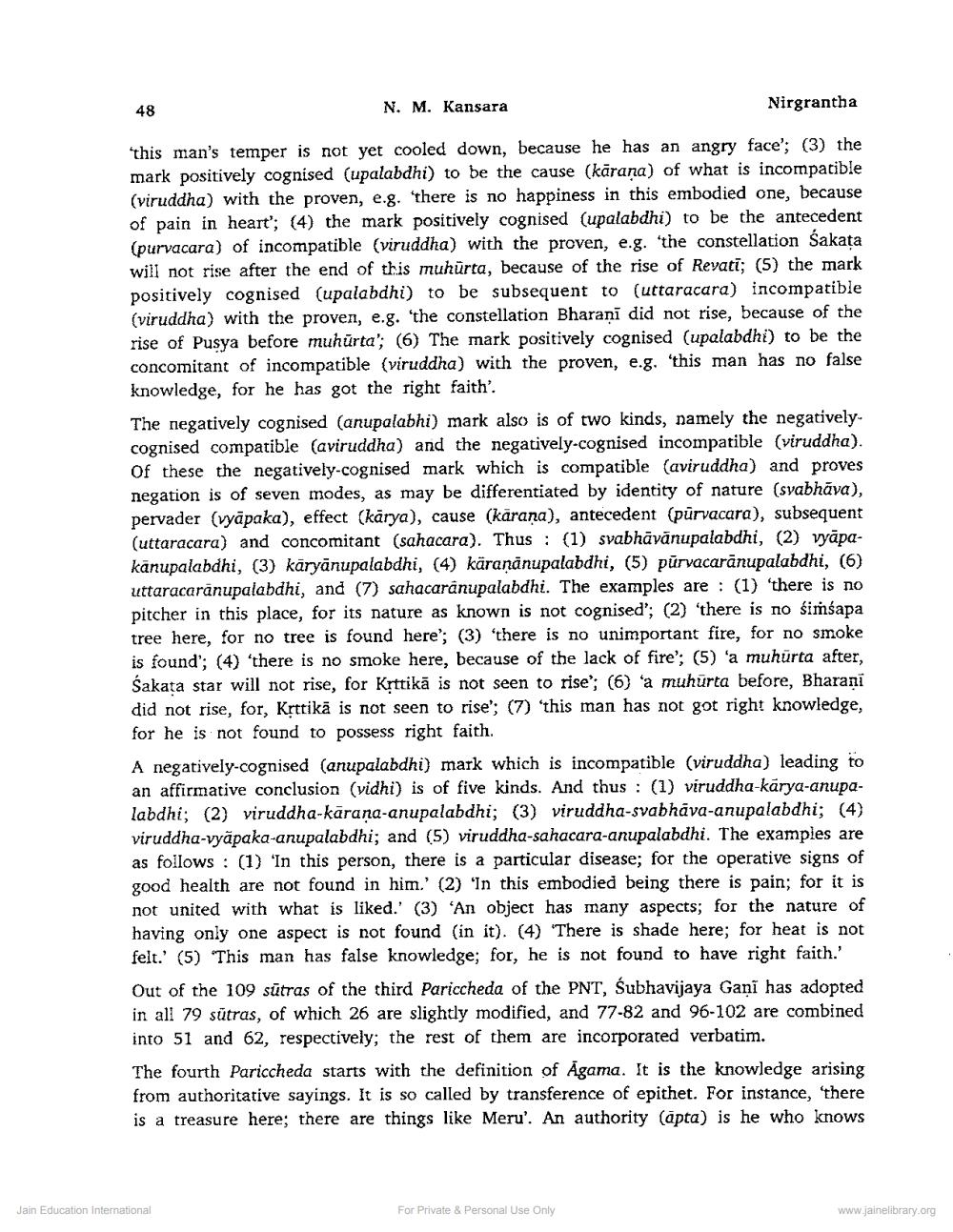Book Title: Syadvadbhasa of Shubhvijay Gani Author(s): N M Kansara Publisher: Z_Nirgrantha_1_022701.pdf and Nirgrantha_2_022702.pdf and Nirgrantha_3_022703.pdf View full book textPage 6
________________ 48 N. M. Kansara Nirgrantha "this man's temper is not yet cooled down, because he has an angry face'; (3) the mark positively cognised (upalabdhi) to be the cause (kārana) of what is incompatible (viruddha) with the proven, e.g. 'there is no happiness in this embodied one, because of pain in heart'; (4) the mark positively cognised (upalabdhi) to be the antecedent (purvacara) of incompatible (viruddha) with the proven, e.g. 'the constellation Śakata will not rise after the end of this muhurta, because of the rise of Revati; (5) the mark positively cognised (upalabdhi) to be subsequent to (uttaracara) incompatible (viruddha) with the proven, e.g. 'the constellation Bharanī did not rise, because of the rise of Pusya before muhurta'; (6) The mark positively cognised (upalabdhi) to be the concomitant of incompatible (viruddha) with the proven, e.g. 'this man has no false knowledge, for he has got the right faith'. The negatively cognised (anupalabhi) mark also is of two kinds, namely the negatively. cognised compatible (aviruddha) and the negatively-cognised incompatible (viruddha). Of these the negatively-cognised mark which is compatible (aviruddha) and proves negation is of seven modes, as may be differentiated by identity of nature (syabhāva), pervader (vyāpaka), effect (kārya), cause (kārana), antecedent (pūrvacara), subsequent (uttaracara) and concomitant (sahacara). Thus : (1) svabhāvānupalabdhi, (2) vyāpakānupalabdhi, (3) kāryānupalabdhi, (4) käranānupalabdhi, (5) pūrvacarānupalabdhi, (6) uttaracaranupalabdhi, and (7) sahacaranupalabdhi. The examples are: (1) there is no pitcher in this place, for its nature as known is not cognised'; (2) 'there is no simśapa tree here, for no tree is found here'; (3) 'there is no unimportant fire, for no smoke is found'; (4) 'there is no smoke here, because of the lack of fire'; (5) 'a muhurta after, Sakata star will not rise, for Kịttikā is not seen to rise'; (6) 'a muhurta before, Bharani did not rise, for, Krttikā is not seen to rise' (7) 'this man has not got right knowledge, for he is not found to possess right faith. A negatively-cognised (anupalabdhi) mark which is incompatible (viruddha) leading to an affirmative conclusion (vidhi) is of five kinds. And thus : (1) viruddha-karya-anupalabdhi; (2) viruddha-kārana-anupalabdhi; (3) viruddha-svabhāva-anupalabdhi; (4) viruddha-vyäpaka-anupalabdhi; and (5) viruddha-sahacara-anupalabdhi. The examples are as follows: (1) 'In this person, there is a particular disease; for the operative signs of good health are not found in him.' (2) 'In this embodied being there is pain; for it is not united with what is liked.' (3) 'An object has many aspects; for the nature of having only one aspect is not found in it). (4) 'There is shade here; for heat is not felt.' (5) 'This man has false knowledge; for, he is not found to have right faith.' Out of the 109 sūtras of the third Pariccheda of the PNT, śubhavijaya Gani has adopted in all 79 sütras, of which 26 are slightly modified, and 77-82 and 96-102 are combined into 51 and 62, respectively; the rest of them are incorporated verbatim. The fourth Pariccheda starts with the definition of Agama. It is the knowledge arising from authoritative sayings. It is so called by transference of epithet. For instance, 'there is a treasure here; there are things like Meru'. An authority (apta) is he who knows Jain Education International For Private & Personal Use Only For Private & Personal Use Only www.jainelibrary.orgPage Navigation
1 ... 4 5 6 7 8
